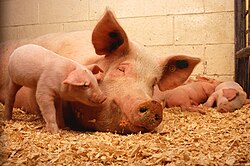This is an old revision of this page, as edited by 203.152.97.217 (talk) at 22:26, 21 March 2007 (→Breeds of pigs). The present address (URL) is a permanent link to this revision, which may differ significantly from the current revision.
Revision as of 22:26, 21 March 2007 by 203.152.97.217 (talk) (→Breeds of pigs)(diff) ← Previous revision | Latest revision (diff) | Newer revision → (diff)| Domestic Pig | |
|---|---|

| |
| Sow and five piglets | |
| Conservation status | |
| Template:StatusDomesticated | |
| Scientific classification | |
| Kingdom: | Animalia |
| Phylum: | Chordata |
| Class: | Mammalia |
| Order: | Artiodactyla |
| Family: | Suidae |
| Genus: | Sus |
| Species: | S. scrofa |
| Subspecies: | S. s. domestica |
| Trinomial name | |
| Sus scrofa domestica Linnaeus, 1758 | |
| Synonyms | |
|
| |
The domestic pig (Sus scrofa domestica) is usually given the scientific name Sus scrofa, though some authors call it S. domestica, reserving S. scrofa for the wild boar. It was domesticated approximately 5,000 to 7,000 years ago. Pigs are found across Europe, the Middle East and extend into Asia as far as Indonesia and Japan. The distinction between wild and domestic animals is slight, and domestic pigs have become feral in many parts of the world (for example, New Zealand) and caused substantial environmental damage.
Sus scrofa has four subspecies, each occupying distinct geographical areas:
- Sus scrofa scrofa (western Africa, Europe)
- Sus scrofa ussuricus (northern Asia and Japan)
- Sus scrofa cristatus (Asia Minor, India)
- Sus scrofa vittatus (Indonesia)
Pigs are one of the oldest forms of livestock, having been domesticated as early as 7000 BC . It is believed to have been domesticated either in the Near East or in China from the Wild Boar. The adaptable nature and omnivorous diet of the Wild Boar allowed early humans to domesticate it much earlier than many other forms of livestock, such as cattle. Pigs were mostly used for food, but people also used their hide for shields, their bones for tools and weapons, and their bristles for brushes. Pigs were brought to southeastern North America from Europe by De Soto and other early Spanish explorers. Escaped pigs became feral and were freely used by Native Americans as food.
As food

| Global pig stock | |
|---|---|
| in 2005 | |
| Number in millions | |
| 1. | 488.8 (50.87%) |
| 2. | 60.4 (6.29%) |
| 3. | 33.2 (3.46%) |
| 4. | 27 (2.81%) |
| 5. | 26.9 (2.8%) |
| 6. | 25.3 (2.63%) |
| 7. | 18 (1.87%) |
| 8. | 15 (1.56%) |
| 9. | 14.7 (1.53%) |
| 10. | 14.6 (1.52%) |
| World total | 960.8 |
| Source: UN Food and Agriculture Organization | |
The domestic pig is farmed for its meat called pork. Products made of pork include sausage, bacon and ham. The head of a pig can be used to make head cheese. Liver, chitterlings, and other offal from pigs are also widely used for food.
In some religions, such as Judaism and Islam, there are religious restrictions on the consumption of pork.
In industrialized nations, domestic pigs farming has shifted away from the traditional pig farm to large-scale intensive pig farms where meat can be mass-produced. This has resulted in lower production costs, but more significant animal welfare concerns.

In developing nations, and some parts of developed nations, the domestic pig is frequently raised outdoors in yards. In some cases pigs are even raised in open fields where they are allowed to forage; they are watched by swineherds, essentially shepherds for pigs.
As pets
Pigs are known to be intelligent animals and have been found to be more trainable than dogs or cats. Asian pot-bellied pigs, a smaller subspecies of the domestic pig, have made popular house pets in the United States beginning in the latter half of the 20th century. Regular domestic farmyard pigs have also been known to be kept indoors, but due to their large size and destructive tendencies, they typically need to be moved into an outdoor pen as they grow older. Most pigs also have an extreme fear of being picked up, but will usually calm down once placed back on the floor.
See also
References
- Template:IUCN2006
- The Humane Society of the United States
- Factory Farming Photo Gallery
- Factory Pork Production